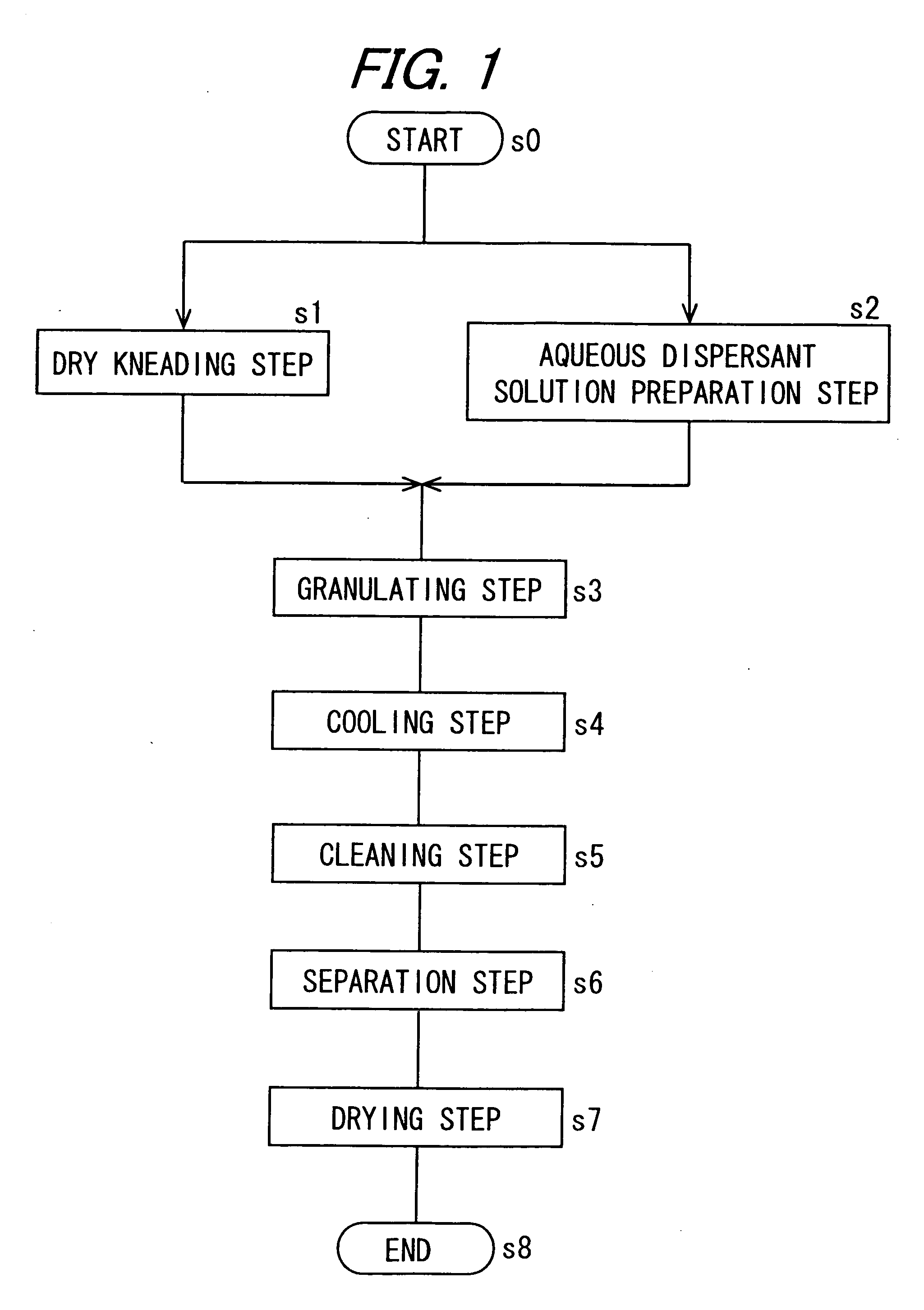Toner and manufacturing method thereof
a technology of toner and manufacturing method, applied in the field of toner, can solve the problems of color shedding to images, lowering the transferability of toner images, and lowering the image density or white background fog, etc., and achieves the effects of low temperature fixing property, low dispersibility of colorant and additive, and easy mixing operation
- Summary
- Abstract
- Description
- Claims
- Application Information
AI Technical Summary
Benefits of technology
Problems solved by technology
Method used
Image
Examples
example 1
[0173] [Dry Kneading Step]
[0174] Copper phthalocyanine (C. I. pigment blue 15:3) as a colorant was added to a crosslinked polyester resin comprising 25 parts of terephthalic acid, 20 parts of isophthalic acid, 5 parts of trimellitic acid anhydride, 40 parts of polyoxypropylene(2.2)-2,2-bis(4-hydroxyphenyl)propane, and 10 parts of ethylene glycol as raw materials (glass transition point (Tg): 62° C., softening point: 130° C., THF insoluble component: 0.5% by weight, weight average molecular weight: 75,000), they were melt kneaded for 40 min by a kneader set to a temperature of 140° C., to prepare a master batch at a colorant concentration of 40% by weight. Polyoxypropylene(2.2)-2,2-bis(4-hydroxyphenyl)propane is a compound formed by adding 2.2 mol in average of propylene oxide to 1 mol of 2,2-bis(4-hydroxyphenyl)propane.
[0175] Then, 80.5 parts of the same crosslinked polyester resin as used for the preparation of the master batch (THF insoluble component: 0.5% by weight), 12.5 parts...
example 2
[0186] Colorant-containing resin particles were obtained by the same operation as in Example 1 except for using, instead of the crosslinked polyester resin with 0.5% by weight of the THF insoluble component, a crosslinked polyester resin having 10% by weight of the THF insoluble component comprising 35 parts of terephthalic acid, 10 parts of isophthalic acid, 5 parts of trimellitic acid anhydride, 20 parts of polyoxyethylene (2.2)-2,2-bis(4-hydroxyphenyl)propane, and 10 parts of ethylene glycol as the starting material (glass transition point (Tg): 62° C., softening point: 130° C., weight average molecular weight: 30,000) in the preparation of the kneaded resin product in the dry kneading step. When the obtained colorant-containing resin particles were observed under SEM, substantially circular particles were observed in the same manner as in Example 1. Further, particles grown by adhesion of a plurality of particles to each other were not contained.
[0187] The obtained colorant-con...
example 3
[0188] Colorant-containing resin particles were obtained by the same operation as in Example 1 except for using, instead of the crosslinked polyester resin with 0.5% by weight of the THF insoluble component, a crosslinked polyester resin with 29% by weight of the THF insoluble component comprising 40 parts of terephthalic acid, 8 parts of trimellitic acid anhydride, 2 parts of dodecenyl succinic acid anhydride, 40 parts of polyoxyethylene (2.2)-2,2-bis(4-hydroxyphenyl) propane, and 10 parts of ethylene glycol as the starting material (glass transition point (Tg): 59° C., softening point: 145° C., weight average molecular weight: 30,000) in the preparation of the kneaded resin product in the dry kneading step. When the obtained colorant-containing resin particles were observed under SEM, substantially circular particles were observed in the same manner as in Example 1. Further, particles grown by adhesion of a plurality of particles to each other were not contained.
[0189] The obtain...
PUM
| Property | Measurement | Unit |
|---|---|---|
| softening point | aaaaa | aaaaa |
| softening point | aaaaa | aaaaa |
| glass transition point | aaaaa | aaaaa |
Abstract
Description
Claims
Application Information
 Login to View More
Login to View More - R&D
- Intellectual Property
- Life Sciences
- Materials
- Tech Scout
- Unparalleled Data Quality
- Higher Quality Content
- 60% Fewer Hallucinations
Browse by: Latest US Patents, China's latest patents, Technical Efficacy Thesaurus, Application Domain, Technology Topic, Popular Technical Reports.
© 2025 PatSnap. All rights reserved.Legal|Privacy policy|Modern Slavery Act Transparency Statement|Sitemap|About US| Contact US: help@patsnap.com


